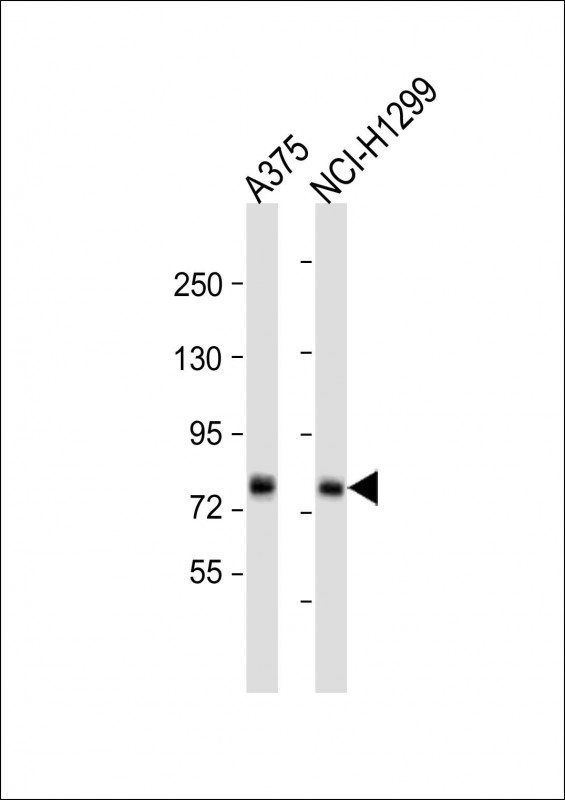TAS1R1 Antibody (Center)
Affinity Purified Rabbit Polyclonal Antibody (Pab)
- SPECIFICATION
- CITATIONS
- PROTOCOLS
- BACKGROUND

Application
| WB, E |
|---|---|
| Primary Accession | Q7RTX1 |
| Other Accession | NP_619642.2 |
| Reactivity | Human |
| Host | Rabbit |
| Clonality | Polyclonal |
| Isotype | Rabbit IgG |
| Calculated MW | 93074 Da |
| Antigen Region | 323-351 aa |
| Gene ID | 80835 |
|---|---|
| Other Names | Taste receptor type 1 member 1, G-protein coupled receptor 70, TAS1R1, GPR70, T1R1, TR1 |
| Target/Specificity | This TAS1R1 antibody is generated from rabbits immunized with a KLH conjugated synthetic peptide between 323-351 amino acids from the Central region of human TAS1R1. |
| Dilution | WB~~1:1000 E~~Use at an assay dependent concentration. |
| Format | Purified polyclonal antibody supplied in PBS with 0.09% (W/V) sodium azide. This antibody is purified through a protein A column, followed by peptide affinity purification. |
| Storage | Maintain refrigerated at 2-8°C for up to 2 weeks. For long term storage store at -20°C in small aliquots to prevent freeze-thaw cycles. |
| Precautions | TAS1R1 Antibody (Center) is for research use only and not for use in diagnostic or therapeutic procedures. |
| Name | TAS1R1 |
|---|---|
| Synonyms | GPR70, T1R1, TR1 |
| Function | Putative taste receptor. TAS1R1/TAS1R3 responds to the umami taste stimulus (the taste of monosodium glutamate). Sequence differences within and between species can significantly influence the selectivity and specificity of taste responses. |
| Cellular Location | Cell membrane; Multi-pass membrane protein. |

Thousands of laboratories across the world have published research that depended on the performance of antibodies from Abcepta to advance their research. Check out links to articles that cite our products in major peer-reviewed journals, organized by research category.
info@abcepta.com, and receive a free "I Love Antibodies" mug.
Provided below are standard protocols that you may find useful for product applications.
Background
The protein encoded by this gene is a G protein-coupled receptor and is a component of the heterodimeric amino acid taste receptor T1R1+3. The T1R1+3 receptor responds to L-amino acids but not to D-enantiomers or other compounds. Most amino acids that are perceived as sweet activate T1R1+3, and this activation is strictly dependent on an intact T1R1+3 heterodimer. Multiple transcript variants encoding different isoforms have been found for this gene.
References
Fushan, A.A., et al. Chem. Senses 35(7):579-592(2010)
Pinheiro, A.P., et al. Am. J. Med. Genet. B Neuropsychiatr. Genet. 153B (5), 1070-1080 (2010) :
Prezeau, L., et al. Curr Opin Pharmacol 10(1):6-13(2010)
Chandrashekar, J., et al. Nature 444(7117):288-294(2006)
Xu, H., et al. Proc. Natl. Acad. Sci. U.S.A. 101(39):14258-14263(2004)
If you have used an Abcepta product and would like to share how it has performed, please click on the "Submit Review" button and provide the requested information. Our staff will examine and post your review and contact you if needed.
If you have any additional inquiries please email technical services at tech@abcepta.com.













 Foundational characteristics of cancer include proliferation, angiogenesis, migration, evasion of apoptosis, and cellular immortality. Find key markers for these cellular processes and antibodies to detect them.
Foundational characteristics of cancer include proliferation, angiogenesis, migration, evasion of apoptosis, and cellular immortality. Find key markers for these cellular processes and antibodies to detect them. The SUMOplot™ Analysis Program predicts and scores sumoylation sites in your protein. SUMOylation is a post-translational modification involved in various cellular processes, such as nuclear-cytosolic transport, transcriptional regulation, apoptosis, protein stability, response to stress, and progression through the cell cycle.
The SUMOplot™ Analysis Program predicts and scores sumoylation sites in your protein. SUMOylation is a post-translational modification involved in various cellular processes, such as nuclear-cytosolic transport, transcriptional regulation, apoptosis, protein stability, response to stress, and progression through the cell cycle. The Autophagy Receptor Motif Plotter predicts and scores autophagy receptor binding sites in your protein. Identifying proteins connected to this pathway is critical to understanding the role of autophagy in physiological as well as pathological processes such as development, differentiation, neurodegenerative diseases, stress, infection, and cancer.
The Autophagy Receptor Motif Plotter predicts and scores autophagy receptor binding sites in your protein. Identifying proteins connected to this pathway is critical to understanding the role of autophagy in physiological as well as pathological processes such as development, differentiation, neurodegenerative diseases, stress, infection, and cancer.


